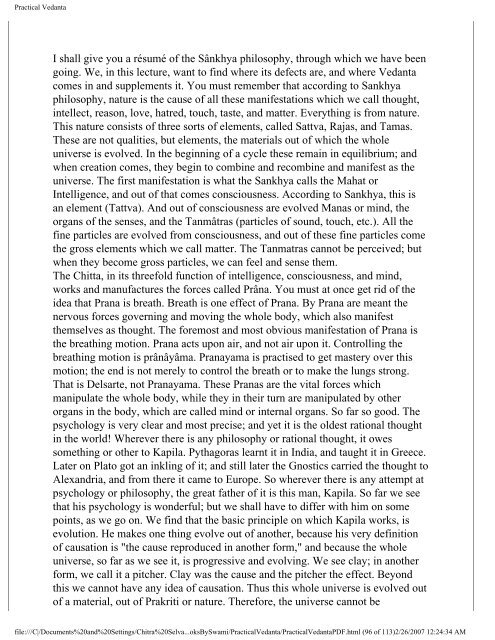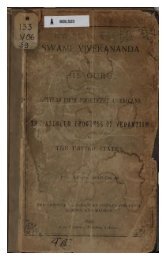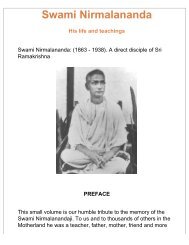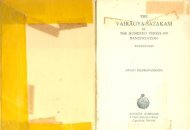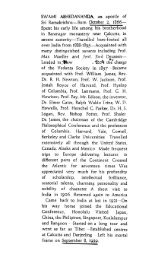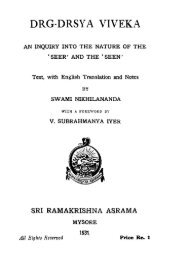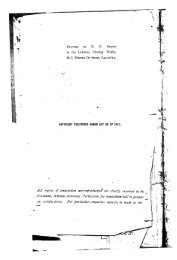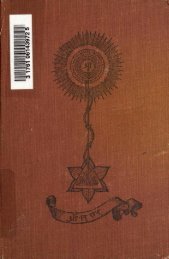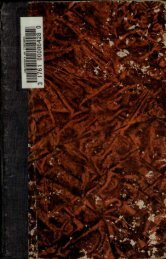<strong>Practical</strong> <strong>Vedanta</strong>I shall give you a résumé of the Sânkhya philosophy, through which we have beengoing. We, in this lecture, want to find where its defects are, and where <strong>Vedanta</strong>comes in and supplements it. You must remember that according to Sankhyaphilosophy, nature is the cause of all these manifestations which we call thought,intellect, reason, love, hatred, touch, taste, and matter. Everything is from nature.This nature consists of three sorts of elements, called Sattva, Rajas, and Tamas.These are not qualities, but elements, the materials out of which the wholeuniverse is evolved. In the beginning of a cycle these remain in equilibrium; andwhen creation comes, they begin to combine and recombine and manifest as theuniverse. The first manifestation is what the Sankhya calls the Mahat orIntelligence, and out of that comes consciousness. According to Sankhya, this isan element (Tattva). And out of consciousness are evolved Manas or mind, theorgans of the senses, and the Tanmâtras (particles of sound, touch, etc.). All thefine particles are evolved from consciousness, and out of these fine particles comethe gross elements which we call matter. The Tanmatras cannot be perceived; butwhen they become gross particles, we can feel and sense them.The Chitta, in its threefold function of intelligence, consciousness, and mind,works and manufactures the forces called Prâna. You must at once get rid of theidea that Prana is breath. Breath is one effect of Prana. By Prana are meant thenervous forces governing and moving the whole body, which also manifestthemselves as thought. The foremost and most obvious manifestation of Prana isthe breathing motion. Prana acts upon air, and not air upon it. Controlling thebreathing motion is prânâyâma. Pranayama is practised to get mastery over thismotion; the end is not merely to control the breath or to make the lungs strong.That is Delsarte, not Pranayama. These Pranas are the vital forces whichmanipulate the whole body, while they in their turn are manipulated by otherorgans in the body, which are called mind or internal organs. So far so good. Thepsychology is very clear and most precise; and yet it is the oldest rational thoughtin the world! Wherever there is any philosophy or rational thought, it owessomething or other to Kapila. Pythagoras learnt it in India, and taught it in Greece.Later on Plato got an inkling of it; and still later the Gnostics carried the thought toAlexandria, and from there it came to Europe. So wherever there is any attempt atpsychology or philosophy, the great father of it is this man, Kapila. So far we seethat his psychology is wonderful; but we shall have to differ with him on somepoints, as we go on. We find that the basic principle on which Kapila works, isevolution. He makes one thing evolve out of another, because his very definitionof causation is "the cause reproduced in another form," and because the wholeuniverse, so far as we see it, is progressive and evolving. We see clay; in anotherform, we call it a pitcher. Clay was the cause and the pitcher the effect. Beyondthis we cannot have any idea of causation. Thus this whole universe is evolved outof a material, out of Prakriti or nature. Therefore, the universe cannot befile:///C|/Documents%20and%20Settings/Chitra%20Selva...oksBySwami/<strong>Practical</strong><strong>Vedanta</strong>/<strong>Practical</strong><strong>Vedanta</strong>PDF.html (96 of 113)2/26/2007 12:24:34 AM
<strong>Practical</strong> <strong>Vedanta</strong>essentially different from its cause. According to Kapila, from undifferentiatednature to thought or intellect, not one of them is what he calls the "Enjoyer" or"Enlightener". Just as is a lump of clay, so is a lump of mind. By itself the mindhas no light; but ate see it reasons. Therefore there must be some one behind it,whose light is percolating through Mahat and consciousness, and subsequentmodifications, and this is what Kapila calls the Purusha, the Self of the Vedantin.According to Kapila, the Purusha is a simple entity, not a compound; he isimmaterial, the only one who is immaterial, and all these various manifestationsare material. I see a black-board. First, the external instruments will bring thatsensation to the nerve-centre, to the Indriya according to Kapila; from the centre itwill go to the mind and make an impression; the mind will present it to theBuddhi, but Buddhi cannot act; the action comes, as it were, from the Purushabehind. These, so to speak, are all his servants, bringing the sensations to him, andhe, as it were, gives the orders, reacts, is the enjoyer, the perceiver, the real One,the King on his throne, the Self of man, who is immaterial. Because he isimmaterial, it necessarily follows that he must be infinite, he cannot have anylimitation whatever. Each one of the Purushas is omnipresent; each one of us isomnipresent, but we can act only through the Linga Sharira, the fine body. Themind, the self-consciousness, the organs, and the vital forces compose the finebody or sheath, what in Christian philosophy is called the spiritual body of man. Itis this body that gets salvation, or punishment, or heaven, that incarnates andreincarnates, because we see from the very beginning that the going and thecoming of the Purusha or soul are impossible. Motion means going or coming, andwhat goes or comes from one place to another cannot be omnipresent. Thus far wesee from Kapila's psychology that the soul is infinite, and that the soul is the onlything which is not composed of nature. He is the only one that is outside of nature,but he has got bound by nature, apparently. Nature is around him, and he hasidentified himself with it. He thinks, "I am the Linga Sharira", "I am the grossmatter, the gross body", and as such he enjoys pleasure and pain, but they do notreally belong to him, they belong to this Linga Sharira or the fine body.The meditative state is called always the highest state by the Yogi, when it isneither a passive nor an active state; in it you approach nearest to the Purusha. Thesoul has neither pleasure nor pain; it is the witness of everything, the eternalwitness of all work, but it takes no fruits from any work. As the sun is the cause ofsight of every eye, but is not itself affected by any defects in the eye or as when acrystal has red or blue flowers placed before it, the crystal looks red or blue, andyet it is neither; so, the soul is neither passive nor active, it is beyond both. Thenearest way of expressing this state of the soul is that it is meditation. This isSankhya philosophy.Next, Sankhya says, that the manifestation of nature is for the soul; allcombinations are for some third person. The combinations which you call nature,these constant changes are going on for the enjoyment of the soul, for itsliberation, that it may gain all this experience from the lowest to the highest. Whenfile:///C|/Documents%20and%20Settings/Chitra%20Selva...oksBySwami/<strong>Practical</strong><strong>Vedanta</strong>/<strong>Practical</strong><strong>Vedanta</strong>PDF.html (97 of 113)2/26/2007 12:24:34 AM
- Page 1 and 2:
Practical VedantaPractical VedantaP
- Page 3 and 4:
Practical Vedantaworld. If I am a s
- Page 5 and 6:
Practical Vedantadifference is only
- Page 7 and 8:
Practical VedantaThe ideal of faith
- Page 9 and 10:
Practical Vedantamoment of our live
- Page 11 and 12:
Practical Vedantaof the Christs and
- Page 13 and 14:
Practical Vedanta"This life is Brah
- Page 15 and 16:
Practical Vedantadark fifteen days,
- Page 17 and 18:
Practical Vedantalife. This is the
- Page 19 and 20:
Practical Vedantaeverything would b
- Page 21 and 22:
Practical Vedantait is only through
- Page 23 and 24:
Practical Vedantawhich is that subt
- Page 25 and 26:
Practical Vedantanoumenon and pheno
- Page 27 and 28:
Practical Vedantato which is the be
- Page 29 and 30:
Practical VedantaAbsolute.The finit
- Page 31 and 32:
Practical Vedantawhich is not the q
- Page 33 and 34:
Practical Vedantaexperience that th
- Page 35 and 36:
Practical Vedantafulfilled. The Jiv
- Page 37 and 38:
Practical Vedantabetween the pure r
- Page 39 and 40:
Practical Vedantacome out straight.
- Page 41 and 42:
Practical Vedantawar with one anoth
- Page 43 and 44:
Practical Vedantanobody could under
- Page 45 and 46: Practical VedantaMy idea, therefore
- Page 47 and 48: Practical Vedantathe same methods.
- Page 49 and 50: Practical Vedantavarious minds, all
- Page 51 and 52: Practical Vedantabrotherhood; but t
- Page 53 and 54: Practical Vedantabrotherhood, but w
- Page 55 and 56: Practical Vedantawe all go with ves
- Page 57 and 58: Practical Vedantareason. What can y
- Page 59 and 60: Practical Vedantabeen preached in t
- Page 61 and 62: Practical Vedantathe husband kisses
- Page 63 and 64: Practical Vedantaof the knowledge a
- Page 65 and 66: Practical Vedantafor those who only
- Page 67 and 68: Practical Vedantasun exists because
- Page 69 and 70: Practical Vedantaof death was pleas
- Page 71 and 72: Practical VedantaGod. We must learn
- Page 73 and 74: Practical Vedantaa plague comes, it
- Page 75 and 76: Practical VedantaAtman? "As with a
- Page 77 and 78: Practical Vedantathat immortal One,
- Page 79 and 80: Practical Vedantaand the third egoi
- Page 81 and 82: Practical VedantaWitness of the uni
- Page 83 and 84: Practical VedantaPractical Vedanta1
- Page 85 and 86: Practical Vedantaeternal ; every ot
- Page 87 and 88: Practical Vedantafaculty, Buddhi, w
- Page 89 and 90: Practical VedantaPractical Vedanta1
- Page 91 and 92: Practical Vedantastepping-stone to
- Page 93 and 94: Practical Vedantarecognition? Findi
- Page 95: Practical Vedantasentient." This is
- Page 99 and 100: Practical Vedantaexistence is limit
- Page 101 and 102: Practical Vedantalive, for I am lif
- Page 103 and 104: Practical Vedantasee from Kapila's
- Page 105 and 106: Practical Vedantalimitation, but th
- Page 107 and 108: Practical Vedantaperfect, infinite,
- Page 109 and 110: Practical Vedantaindividuality, of
- Page 111 and 112: Practical Vedantarepeat [something]
- Page 113: Practical Vedantaperson who dies in


